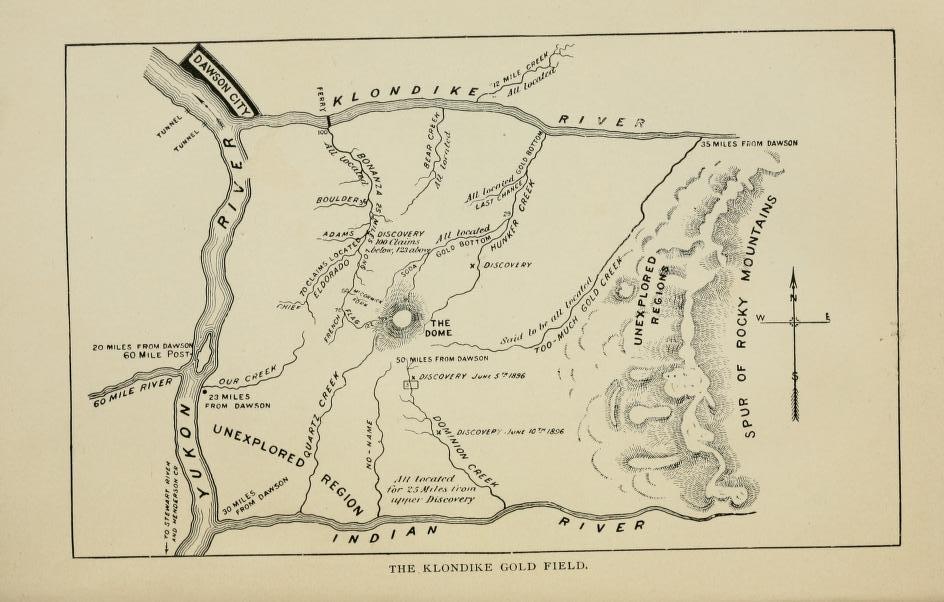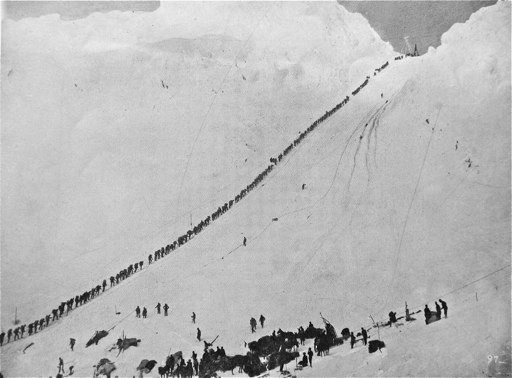The Gold Rush
Canada is a Northern country and its history as one will forever change in the summer of 1896 when George Carmack, an American prospector, along with two Tagish First Nations members struck gold on Rabbit Creek (later renamed Bonanza Creek). This discovery will spark an incredible stampede of prospectors, mainly from the United States, who will take up the adventure of a lifetime in the hopes of securing a portion of this new found wealth (Klondike Gold Rush).
Sources tell us that more than 100,000 men and women from all walks of life including the mayor of Seattle, "set out for the New Eldorado". This exodus was mainly due to the fact that the financial crisis and depression that had hit the United States had been quite severe (The Gold of the Yukon, 14).
But getting to the Klondike will be more than some bargained for. There were three passable routes to arrive to the land of gold: the longest but less arduous was by steamer to St. Michael, Alaska to arrive at the mouth of the Yukon; a riverboat was then used to make the journey all the way to the Klondike. The second route was the White pass trail which was a difficult crossing, less difficult than the Chilkoot pass but longer. The last route was the Chilkoot pass which was favoured as it was the shortest one although it was the most difficult one to undertake (Chilkoot Trail, 53).
The word “Chilkoot” means to pack or carry and it is considered to this day as “one of the most rugged and demanding long-distance trails in Canada” (Chilkoot Trail). The Chilkat First nations had built it and used it as “a means of controlling trade and ensuring revenue from the neighboring tribes”. With the advent of the stampeders, it will again serve as a new form of revenue for them (Trail to the Klondike, 42).
Those fortunate enough to get over the pass or other routes in the early days, would make the fortunes they had hoped for. All others would be bitterly disappointed as they will be obliged to either "work along the margins of the creeks that were already staked" or find employment in town (Klondike Gold Rush).
Needless to say that the Gold Rush did not only bring about riches to many prospectors but it also fostered the rapid development of towns such as Dawson City and Klondike Townsite as well as that of the Yukon territory which was officially formed on June 13, 1898. It is safe to speculate that if it had not been for the rush, this territory would have not developped as fast as it did and the rush also left behind the necessary infrastructure, support and governance that were needed to achieve such development (Klondike Gold Rush).
It is important to note that this region of country was the subject of dispute between the United States and Canada since the purchase of Alaska by the U.S from the Russians in 1867. The gold rush was keen to bring this dispute to a head. A joint commission failed to resolve it in 1898-1899 and it is not until 1903 that it was resolved through an international tribunal. Canadians were not impressed with the British negotiations of this dispute as they ended up with less than they had bargained for. Nevertheless, the Klondike and its short-lived gold history would forever belong to Canada (Alaska Boundary Dispute).
Sources: Klondike Gold Rush, The Gold of the Yukon, Chilkoot Trail: Heritage Route to the Klondike, Chilkoot Trail, Trail to the Klondike, Alaska Boundary Dispute

